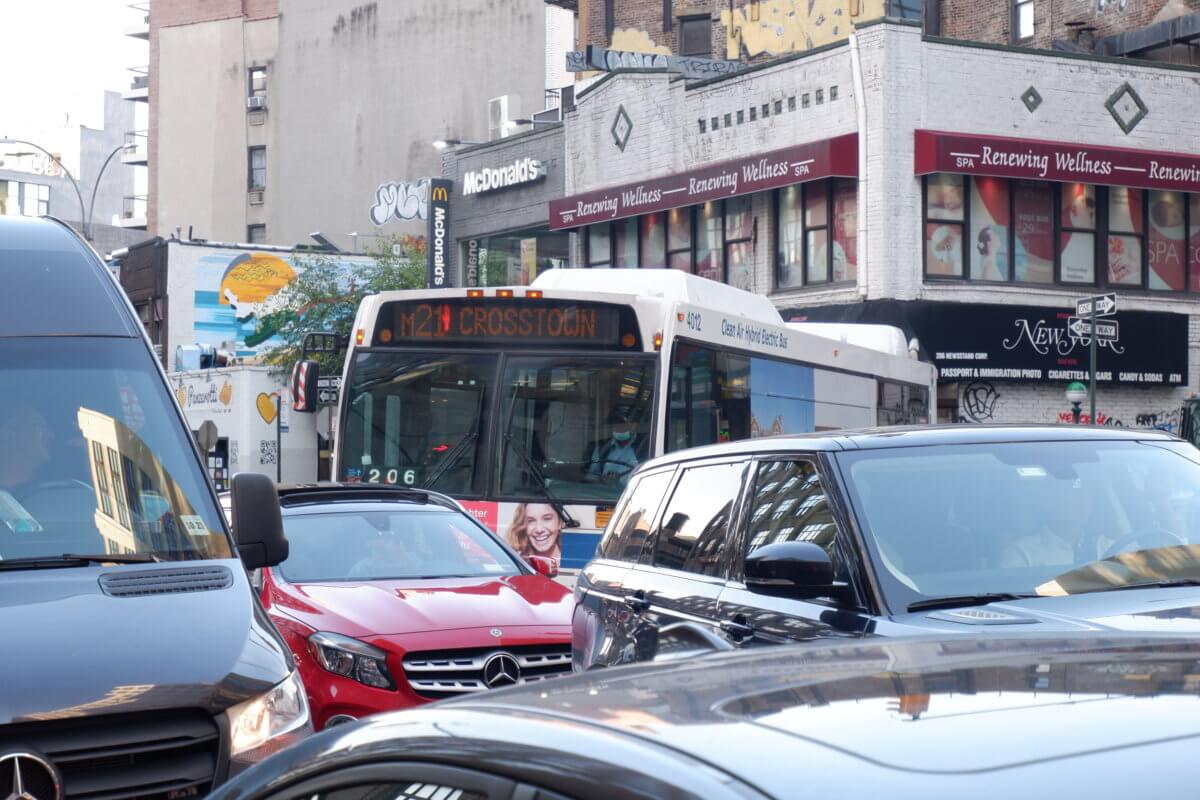
Sign up for our PoliticsNY newsletter for the latest coverage and to stay informed about the 2021 elections in your district and across NYC
Bus speeds have slowed down in all Five Boroughs last month, according to statistics from the Metropolitan Transportation Authority.
The citywide average bus speed in October was 7.9 miles per hour, down from 8.3 mph from October 2020, a 4.8% decrease, figures released Friday by MTA’s New York City Transit show.
Car traffic has returned to almost pre-pandemic levels in recent months, causing congestion on New York City streets and, in one recent case, even regularly cutting short a downtown Manhattan bus route due to the constant gridlock near the Holland Tunnel.
“Our expectation and our concerns are that this trend is going to continue and that the buses are just going to get slower as this uptick in congestion happens,” said Caitlin Pearce, deputy director of the transit advocacy group Riders Alliance.
Buses were the slowest in Manhattan last month at 6 mph, followed by Brooklyn at 7 mph and the Bronx at 7.4 mph.
Queens buses had an average speed of 8.8 mph, and Staten Island topped the city at 13.8 mph — but the people-movers in all five boroughs are running slower than the year before.
Meanwhile, the latest car counts on MTA’s bridges and tunnels logged 27.1 million vehicles crossing the tolled facilities in September, a slight decrease from 29 million in August, but still only 2.6% below September 2019 levels.
Bus ridership was at about 69% of pre-COVID levels, or an average 1.5 million riders a day last month, according to the transit agency.
The bus speeds are still slightly above the 7.4 mph average which put the Big Apple at the bottom of a list of 17 large bus systems in the nation, according to a 2017 report by city Comptroller Scott Stringer.
Other indicators also show sluggish commutes with riders waiting an average 43 seconds longer at bus stops last month and spending one minute and 24 seconds longer on board compared to the same time last year.
The city’s new busways bucked the trend, with speeds increasing 51% on the Main Street busway in Flushing, Queens, and 36% on 181st Street in Manhattan’s Washington Heights.
“Bus lanes and busways really work and they should really be a top priority of an administration,” said Pearce.
The red-painted paths limit most or all through-traffic for private vehicles to speed up buses, debuting on Brooklyn’s Fulton Mall in the 1980s and becoming a more popular public transit improvement tool since the second one opened on Manhattan’s 14th Street in 2019.
The city’s Department of Transportation (DOT) — which designs and oversees the streets — has installed four of the five new busways Mayor Bill de Blasio promised in summer 2020, including most recently a pair in Jamaica, Queens, late last month.
Not all have been equally successful though.
The half-mile Jay Street busway in Downtown Brooklyn slowed down again in recent months after a promising start last year, as more cars illegally drive through the limited-access road and as parking placard abuse persists in business district.
The last de Blasio-era busway on Manhattan’s Fifth Avenue was watered down by DOT and postponed until after hizzoner leaves office at the end of the year, following wealthy local business interests kicking up a stink at the project.
Advocates hope Mayor-elect Eric Adams will steer his administration’s focus toward improving bus rides in 2022.
“This is a key moment with our new administration coming in,” said Pearce. “We’re going to be looking to the mayor to make sure our bus projects move forward.”
That includes working with the MTA on its borough-by-borough bus network redesigns, which relaunched in the Bronx after a pandemic pause.
Another simple step, the advocate noted, is allowing riders to also board through the back door, something MTA plans to pilot on 10 routes.
An MTA spokesman said the agency has earmarked $85 million for bus lane camera enforcement with a goal of installing the cameras at 85% of red lanes by 2023.
“With the COVID-19 pandemic receding, the familiar problem of traffic congestion is returning and the MTA is already taking steps to speed buses using proven solutions,” said Aaron Donovan in a statement. “The MTA has committed $85 million to automated camera enforcement of bus lanes, launched bus-mounted ads highlighting the cameras, and is working with NYC DOT to increase the pace and number of bus lanes and busways.”
A spokesman for DOT said the year has been “transformative” thanks to the four new busways, but pointed back to the state and the need for MTA to launch its downtown Manhattan tolling program known as congestion pricing.
“This year has been transformative for bus riders, and we’re excited to continue working with the MTA on that progress,” said Seth Stein. “At the same time, this again highlights how critical it is to get congestion pricing in place as soon as possible, and to continue our push to get our friends and neighbors to embrace transit, cycling and walking.”
"along" - Google News
November 15, 2021 at 04:00AM
https://ift.tt/3ccew3q
Crawling along: MTA bus speeds are down in all five boroughs, agency stats show | amNewYork - AMNY
"along" - Google News
https://ift.tt/2z4LAdj
https://ift.tt/35rGyU8
Bagikan Berita Ini















0 Response to "Crawling along: MTA bus speeds are down in all five boroughs, agency stats show | amNewYork - AMNY"
Post a Comment